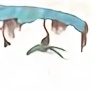HOME | DD
 Tapejara — Midgard - Odd Locomotions
Tapejara — Midgard - Odd Locomotions

#alien #animal #astrobiology #bio #cellular #cephalopod #extraterrestrial #lifeform #midgard #organism #planet #profile #squibbon #squid #starfish #tentacles #world #xenobiology #waynebarlowe
Published: 2011-08-12 02:37:55 +0000 UTC; Views: 8482; Favourites: 74; Downloads: 31
Redirect to original
Description
Here are four life forms of Midgard I drew today (August 11, 2011)The Svin Jostarnor (derived from Pig Starfish) are four legged omnivores that dwell in the forests that surround Midgard's only sea. While many life forms evolved from squid like creatures, Jostarnors evolved from Starfish like creatures, having a fivefold radial symmetry and it is believed that they also used to walk on five legs. Svin Jostarnors modified one of their limbs into a tail for balance and fat storage.
Their locomotion is unique: first they push forward using their front limbs, leaping into the air. Their tail tilts their body backwards so that they then land on their hind legs, and leap forward without their front legs touching the sand. Only after that second leap that they land on their front legs without their hind legs touching the ground. From there, the process continues, making them look like rocking horses.
Like their names hint, Svin Jostarnors will eat anything: roots, nectar, small animals, some species have also been spotted fishing. They can easily find food on the forest floor using sensitive antannae that act as a star-nosed mole's nose appendages. The hairs on their humps keeps sand out of their six nostrils. They have extra pits behind their bodies to detect approaching predators, many of which prey on them.
Gibboner Jostarnors are smaller but more agile than their Svin cousins. They are also forest dwellers but rather live within the branches where they feed on eggs, nectar, folliage and small animals. Most of the time, they slowly crawl along the branches, analysing the environment with their antannae. But when threatened, they quickly swing from branch to branch, flipping their bodies like tossed coins. They can also move that way went hunting small flying creatures, such as beach disks.
Gibboner has several similarities with other Jostarnors. They have six nostrils on top of their bodies which vent the air and provides them the oxygen they need. Instead of eyes, they also have snake like pits to detect the heat of other life forms. One might think they could not see the branches they aim for, but the pits of Midgard are more specialised, granting them heat vision, seeing shades of red and blue.
They also have sandpaper like skin for protection, but Gibboners took it a step further and grew small spikes in strategic areas on their bodies. They have five part beaks to grind food, lungs located in the mantle on their backs, and an red-orange colored bodies. They also have interesting pads on their feet, similar to mammals on Earth such as cats or bears.
NOTE: The Gibboner Jostarnor is infamous for being shown in an incorrect depiction of life on Geb, where it does not reside. There it was shown living in the tundra, with one holding onto a Paranthropod and having eight limbs. The only feature correct was the coloring. This was due to a miscomprehension of data received from both Geb and Midgard which were discovered around the same time, both in late 2006.
++++
Midgard is also known for its gigantic single celled life forms, the largest reaching the size of a viking ship. Two examples are depicted at the bottom of the page.
One the left is the Shard Cellen, derived from the word cell in Swedish. They have a rather sharp and solid body almost like glass. True to that and their name, they live in small colonies at the surface of the sand in the desert. They penetrate the skin of animals who step on them and are hard to remove due to their barbed biology. They are not poisonous, but their presence can still cause an infection which leads to death. The cell feeds off bacteria that gathers around the infected wound. The four flagellums help them bury deeper in their hosts.
The Missiltas on the right are even more sinister. As big as footballs and as fast as torpedoes, they swim quickly in small pods in the sea. They search for the scent of larger animals are propulse themselve through their prey, skewering them alive. When the prey dies, they gather around the free floating corpse and feed using a small membrane that slides through a thin tube in their blade. Their bodies are semi transparent and feel like jelly. They can shift the shape of their three fins to help them navigate through the water. They are named after the Mistle Toe, the plant that formed the arrow that killed the Norse god Baldr.
Hope this was worth reading. And by the way, as of now, creatures from Midgard get names derived from either Norse Mythology or Sweden names.
Related content
Comments: 2

It looks very weird, but very cool at the same time!
👍: 0 ⏩: 0


















